Dynamic Control of Traction Motor for EV Fed via Dual Source Inverter with a Two Battery System
Abstract
:1. Introduction
- Modelling and simulation of the dual-source inverter at constant load and variable speed indicating dynamic behaviour of an EV using two battery sources individually;
- Experimental verification using laboratory prototype of a dual-source inverter to demonstrate the smooth dynamic behaviour for the presented control of an induction motor under normal and emergency operating conditions;
- Experimental result analysis of the dynamic behaviour indicating parameters such as power, power factor, current harmonics, and voltage/current stresses across the switch using both the dc sources individually.
2. Dual-Source Inverter
3. Control of Dual-Source Inverter
4. Performance Simulation
5. Experimental Validation
6. Conclusions
Author Contributions
Funding
Data Availability Statement
Conflicts of Interest
References
- 42 USC 4§7409; National Primary and Secondary Ambient Air Quality Standards. United States Congress: Washington, DC, USA, 1977.
- Cazzola, P.; Gorner, M.; Schuitmaker, R.; Maroney, E. Global EV Outlook 2016; International Energy Agency: Paris, France, 2016. [Google Scholar]
- Song, K.; Wang, X.; Li, F.; Sorrentino, M.; Zheng, B. Pontryagin’s minimum principle-based real-time energy management strategy for fuel cell hybrid electric vehicle considering both fuel economy and power source durability. Energy 2020, 205, 118064. [Google Scholar] [CrossRef]
- Fong, Y.C.; Cheng, K.W.E.; Raman, S.R. A Current Allocation Strategy Based Balancing Technique of Voltage Source String in Switch-Ladder Inverter and Its Switched-Capacitor Variety. IEEE Trans. Energy Convers. 2020, 36, 1081–1089. [Google Scholar] [CrossRef]
- Naderi, E.; Bibek, K.C.; Ansari, M.; Asrari, A. Experimental Validation of a Hybrid Storage Framework to Cope With Fluctuating Power of Hybrid Renewable Energy-Based Systems. IEEE Trans. Energy Convers. 2021, 36, 1991–2001. [Google Scholar] [CrossRef]
- Emadi, A.; Williamson, S.; Khaligh, A. Power electronics intensive solutions for advanced electric, hybrid electric, and fuel cell vehicular power systems. IEEE Trans. Power Electron. 2006, 21, 567–577. [Google Scholar] [CrossRef]
- Perreault, D.; Caliskan, V. Automotive Power Generation and Control. IEEE Trans. Power Electron. 2004, 19, 618–630. [Google Scholar] [CrossRef]
- Rajashekara, K. Power electronics applications in electric/hybrid vehicles. In Proceedings of the 29th Annual Conference of the IEEE Industrial Electronics Society, Roanoke, VA, USA, 2–6 November 2003; Volume 3, pp. 3029–3030. [Google Scholar] [CrossRef]
- Taha, W.; Nahid-Mobarakeh, B.; Bauman, J. Efficiency Evaluation of 2L and 3L SiC-Based Traction Inverters for 400 V and 800 V Electric Vehicle Powertrains. In Proceedings of the 2021 IEEE Transportation Electrification Conference & Expo (ITEC), Chicago, IL, USA, 21–25 June 2021; pp. 625–632. [Google Scholar] [CrossRef]
- Forouzesh, M.; Liu, Y.F.; Sen, P.C. A Reconfigurable Single-Stage Three-Phase Electric Vehicle DC Fast Charger Compatible With Both 400V and 800V Automotive Battery Packs. In Proceedings of the 2022 24th European Conference on Power Electronics and Applications (EPE’22 ECCE Europe), Hanover, Germany, 5–9 September 2022; pp. 1–11. [Google Scholar]
- Abbasi, M.; Kanathipan, K.; Lam, J. An Interleaved Bridgeless Single-Stage AC/DC Converter With Stacked Switches Configurations and Soft-Switching Operation for High-Voltage EV Battery Systems. IEEE Trans. Ind. Appl. 2022, 58, 5533–5545. [Google Scholar] [CrossRef]
- Kim, J.-Y.; Lee, B.-S.; Kwon, D.-H.; Lee, D.-W.; Kim, J.-K. Low Voltage Charging Technique for Electric Vehicles With 800 V Battery. IEEE Trans. Ind. Electron. 2021, 69, 7890–7896. [Google Scholar] [CrossRef]
- Choudhury, A.; Pillay, P.; Williamson, S.S. Comparative Analysis Between Two-Level and Three-Level DC/AC Electric Vehicle Traction Inverters Using a Novel DC-Link Voltage Balancing Algorithm. IEEE J. Emerg. Sel. Top. Power Electron. 2014, 2, 529–540. [Google Scholar] [CrossRef]
- Mukherjee, S.; Giri, S.K.; Kundu, S.; Banerjee, S. A Generalized Discontinuous PWM Scheme for Three-Level NPC Traction Inverter With Minimum Switching Loss for Electric Vehicles. IEEE Trans. Ind. Appl. 2018, 55, 516–528. [Google Scholar] [CrossRef]
- Choudhury, A.; Pillay, P. Space Vector Based Capacitor Voltage Balancing for a Three-Level NPC Traction Inverter Drive. IEEE J. Emerg. Sel. Top. Power Electron. 2019, 8, 1276–1286. [Google Scholar] [CrossRef]
- Choudhury, A.; Pillay, P.; Williamson, S.S. A Hybrid PWM-Based DC-Link Voltage Balancing Algorithm for a Three-Level NPC DC/AC Traction Inverter Drive. IEEE J. Emerg. Sel. Top. Power Electron. 2015, 3, 805–816. [Google Scholar] [CrossRef]
- Gao, Z.; Lu, Q. A Hybrid Cascaded Multilevel Converter Based on Three-Level Cells for Battery Energy Management Applied in Electric Vehicles. IEEE Trans. Power Electron. 2018, 34, 7326–7349. [Google Scholar] [CrossRef]
- Mukherjee, S.; Giri, S.K.; Banerjee, S. A Flexible Discontinuous Modulation Scheme With Hybrid Capacitor Voltage Balancing Strategy for Three-Level N.P.C. Traction Inverter. IEEE Trans. Ind. Electron. 2019, 66, 3333–3343. [Google Scholar] [CrossRef]
- Emadi, A.; Magne, P. Power Converter. U.S. Patent 0117770 A1, 1 May 2014. [Google Scholar]
- Ebrahimi, J.; Salari, O.; Eren, S.; Hashtrudi-Zaad, K.; Bakhshai, A.; Jain, P. Efficiency Improved Multi-Source Inverter for Hybrid Energy Storage Systems in Electric Vehicle Application. IEEE Trans. Power Electron. 2021, 37, 1982–1997. [Google Scholar] [CrossRef]
- Dorn-Gomba, L.; Magne, P.; Danen, B.; Emadi, A. On the Concept of the Multi-Source Inverter for Hybrid Electric Vehicle Powertrains. IEEE Trans. Power Electron. 2017, 33, 7376–7386. [Google Scholar] [CrossRef]
- Dorn-Gomba, L.; Guo, J.; Emadi, A. Multi-Source Inverter for Power-Split Hybrid Electric Powertrains. IEEE Trans. Veh. Technol. 2019, 68, 6481–6494. [Google Scholar] [CrossRef]
- Wang, T.; Zheng, P.; Zhang, Q.; Cheng, S. Design characteristics of the induction motor used for hybrid electric vehicle. IEEE Trans. Magn. 2005, 41, 505–508. [Google Scholar] [CrossRef]
- Nagataki, M.; Kondo, K.; Yamazaki, O.; Yuki, K.; Nakazawa, Y. Online Auto-Tuning Method in Field-Orientation-Controlled Induction Motor Driving Inertial Load. IEEE Open J. Ind. Appl. 2022, 3, 125–140. [Google Scholar] [CrossRef]
- Muduli, U.R.; Beig, A.R.; Behera, R.K.; Al Jaafari, K.; Alsawalhi, J.Y. Predictive Control With Battery Power Sharing Scheme for Dual Open-End-Winding Induction Motor Based Four-Wheel Drive Electric Vehicle. IEEE Trans. Ind. Electron. 2021, 69, 5557–5568. [Google Scholar] [CrossRef]
- Kousalya, V.; Rai, R.; Singh, B. Sliding Model-Based Predictive Torque Control of Induction Motor for Electric Vehicle. IEEE Trans. Ind. Appl. 2021, 58, 742–752. [Google Scholar] [CrossRef]
- Wang, H.; Yang, Y.; Ge, X.; Zuo, Y.; Yue, Y.; Li, S. PLL- and FLL-Based Speed Estimation Schemes for Speed-Sensorless Control of Induction Motor Drives: Review and New Attempts. IEEE Trans. Power Electron. 2021, 37, 3334–3356. [Google Scholar] [CrossRef]
- Salari, O.; Zaad, K.H.; Bakhshai, A.; Jain, P. Pseudo Multi Level Space Vector Modulation Technique for Multi Source Inverters. In Proceedings of the 2021 IEEE Energy Conversion Congress and Exposition (ECCE), Vancouver, BC, Canada, 10–14 October 2021; pp. 4979–4986. [Google Scholar]
- Salari, O.; Zaad, K.H.; Kumar, A.; Bakhshai, A.; Jain, P. On the Concept of Four Nearest Space Vector PWM for Multi Source Inverters. In Proceedings of the 2019 IEEE Energy Conversion Congress and Exposition (ECCE), Baltimore, MD, USA, 29 September–3 October 2019; pp. 1816–1821. [Google Scholar]
- Riache, Y.; Hamdi, E.S. A Novel switching pattern of Modified SVPWM for Z-Source Inverter connected to a Multi-Source System. In Proceedings of the 2018 53rd International Universities Power Engineering Conference (UPEC), Glasgow, UK, 4–7 September 2018; pp. 1–5. [Google Scholar]
- Salari, O.; Nouri, M.; Zaad, K.H.; Bakhshai, A.; Jain, P. Space Vector Modulation for Multi-Source Inverters. In Proceedings of the 2018 IEEE International Power Electronics and Application Conference and Exposition (PEAC), Shenzhen, China, 4–7 November 2018; pp. 1–6. [Google Scholar]
- Luciano, C.; Aganah, K.A.; Ndoye, M.; Oni, B. New Switched-Multi-Source Inverter Topology with Optimum Number of Used Switches. In Proceedings of the 2018 IEEE PES/IAS PowerAfrica, Cape Town, South Africa, 28–29 June 2018; pp. 414–419. [Google Scholar]
- Lawan, M.M.G.; Raharijaona, J.; Camara, M.B.; Dakyo, B. Three level Neutral-Point-Clamped Inverter Control Strategy using SVPWM for Multi-Source System Applications. In Proceedings of the 2019 IEEE International Conference on Industrial Technology (ICIT), Melbourne, Australia, 13–15 February 2019; pp. 562–567. [Google Scholar]
- Chemali, E.; Emadi, A. On the concept of a novel Reconfigurable Multi-Source Inverter. In Proceedings of the 2017 IEEE Transportation Electrification Conference and Expo (ITEC), Harbin, China, 7–10 August 2017; pp. 707–713. [Google Scholar]
- Wildi, T. Electric Machines, Drives and Power Systems; Pearson: London, UK, 2022. [Google Scholar]
- Gudhe, S.; Singh, S. Co-ordinated Control of Two Batteries for Traction Motor and Auxiliary Loads in Electric Vehicle. In Proceedings of the 2022 IEEE 2nd International Conference on Sustainable Energy and Future Electric Transportation (SeFeT), Hyderabad, India, 4–6 August 2022; pp. 1–6. [Google Scholar]
- Fedele, E.; Iannuzzi, D.; Tricoli, P.; Del Pizzo, A. NPC-based Multi-Source Inverters for Multimode DC Rail Traction Systems. IEEE Trans. Transp. Electrif. 2022. Early access. [Google Scholar] [CrossRef]
- Salari, O.; Zaad, K.H.; Bakhshai, A.; Jain, P. Reconfigurable Hybrid Energy Storage System for an Electric Vehicle DC–AC Inverter. IEEE Trans. Power Electron. 2020, 35, 12846–12860. [Google Scholar] [CrossRef]
- Gudhe, S.; Singh, S. Single Stage Multiple Source Bidirectional Converter for Electric Vehicles. In Flexible Electronics for Electric Vehicles; Lecture Notes in Electrical Engineering; Springer: Singapore, 2022; Volume 852, pp. 567–574. [Google Scholar]
- Gudhe, S.; Singh, S. Charging of Multiple Batteries Using Single-Stage Multi-source Converter with Bidirectional Power Flow. In Recent Advances in Power Electronics and Drives; Lecture Notes in Electrical Engineering; Springer: Singapore, 2022; Volume 863, pp. 207–216. [Google Scholar]
- Krishnan, R. Electric Motor Drives: Modeling, Analysis, and Control; Pearson: London, UK, 2005. [Google Scholar]
- Durán, M.J.; Prieto, J.; Barrero, F.; Riveros, J.A.; Guzman, H. Space-Vector P.W.M. With Reduced Common-Mode Voltage for Five-Phase Induction Motor Drives. IEEE Trans. Ind. Electron. 2013, 60, 4159–4168. [Google Scholar] [CrossRef]





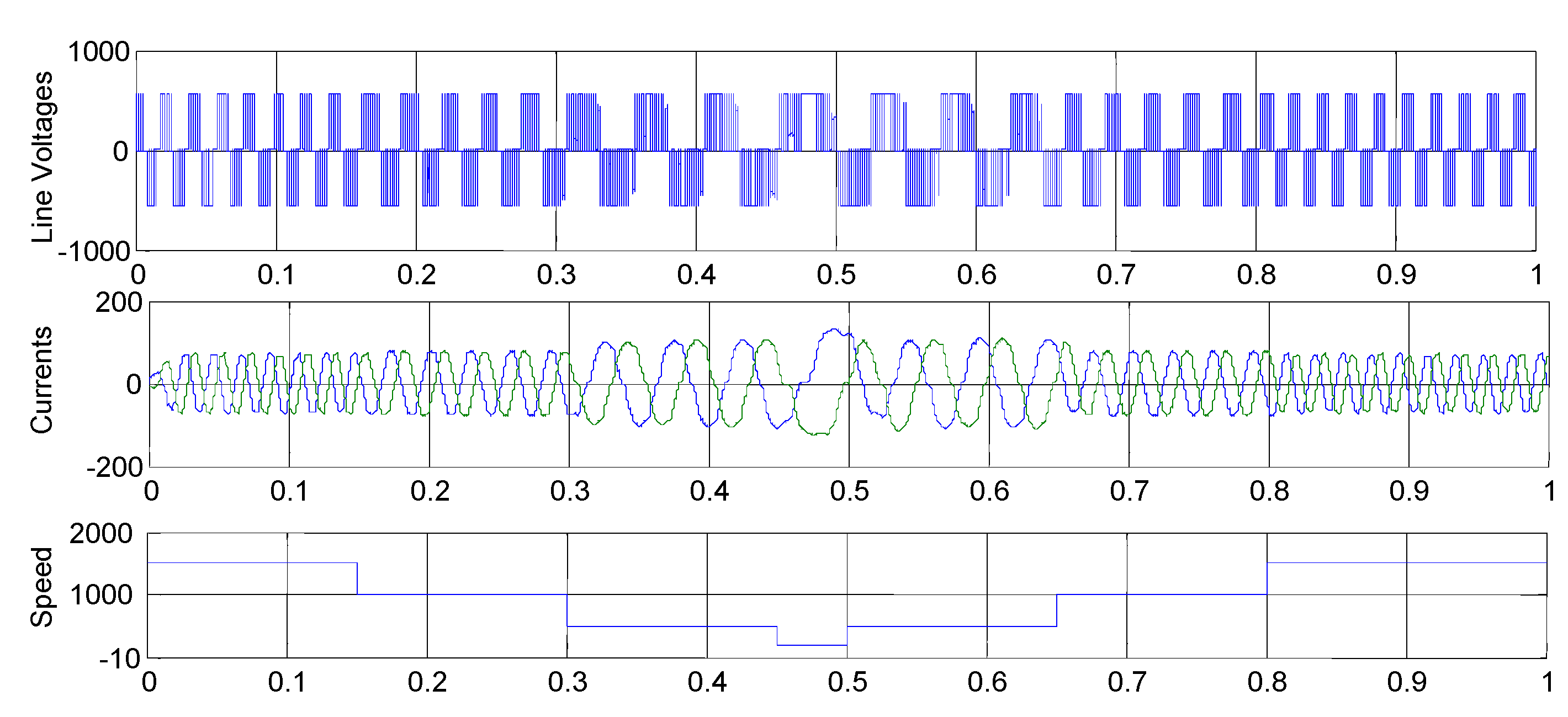

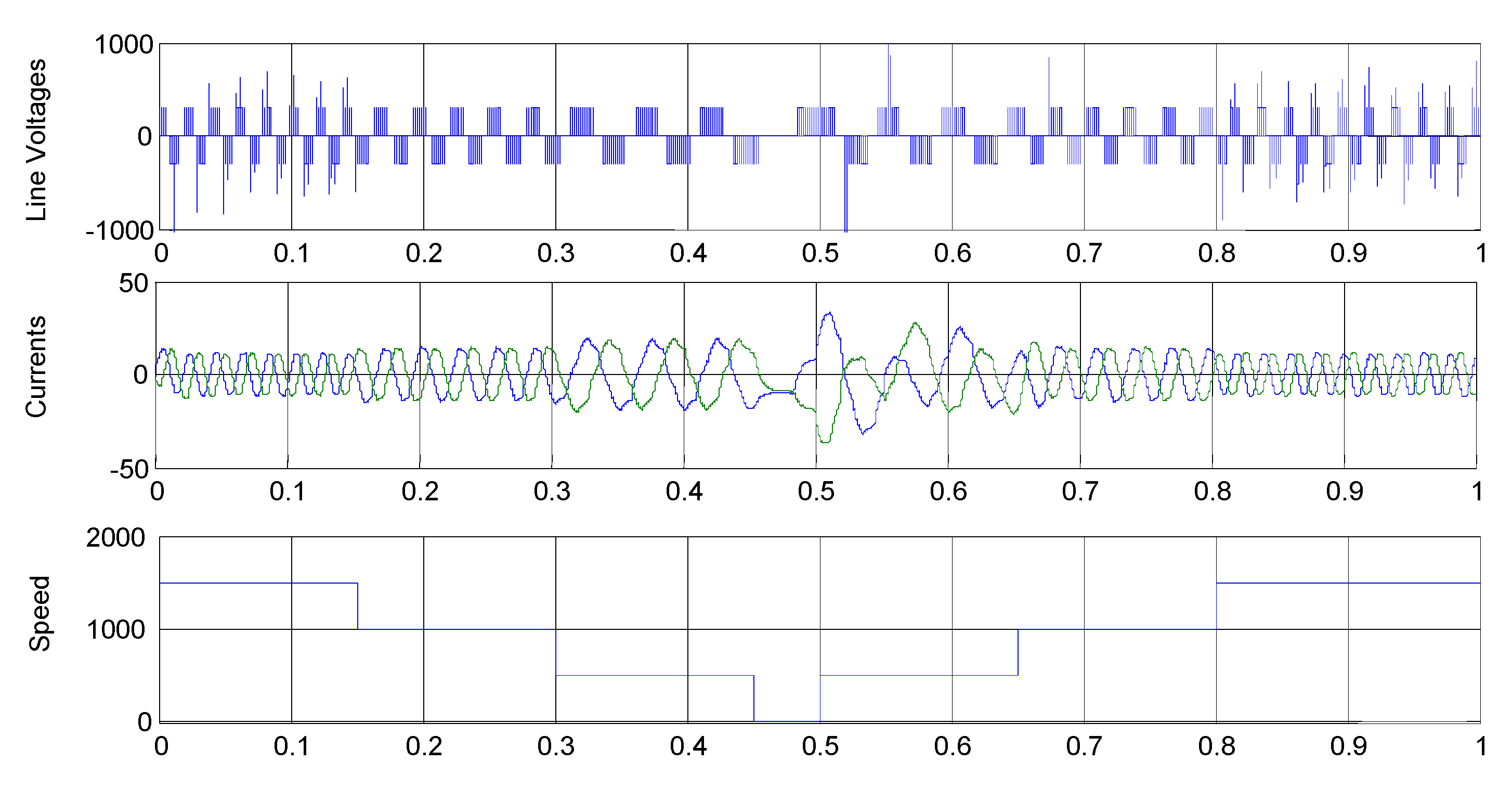
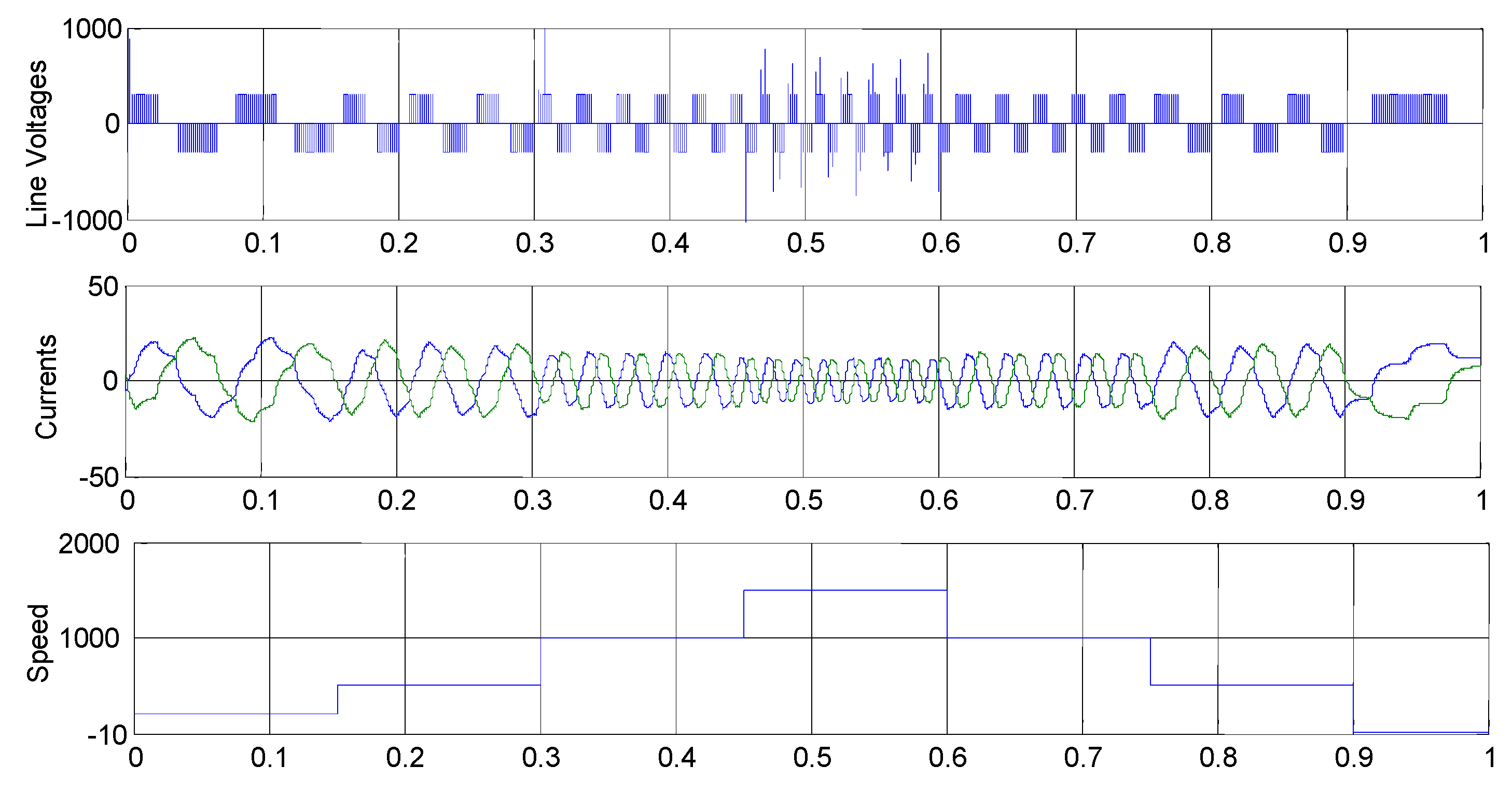
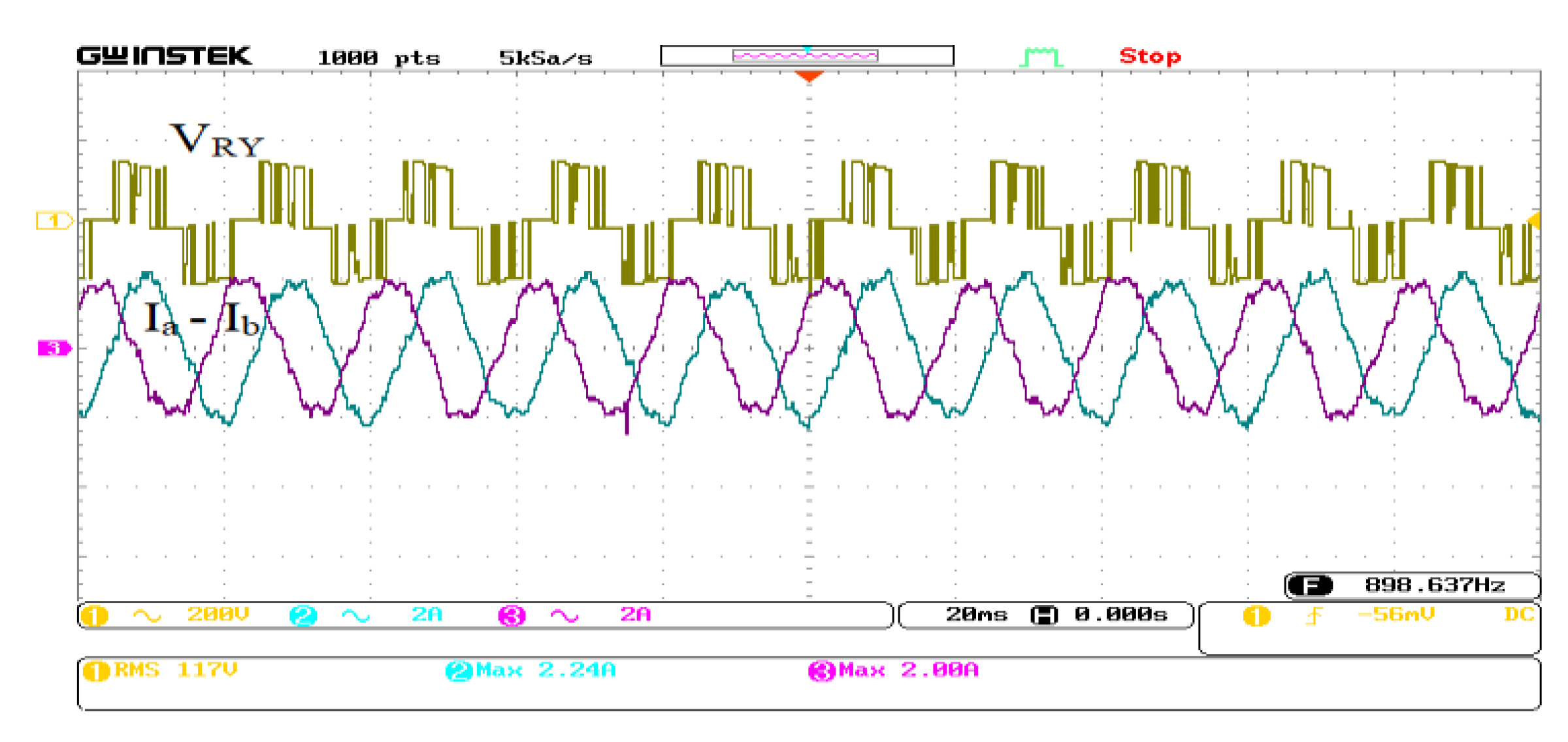




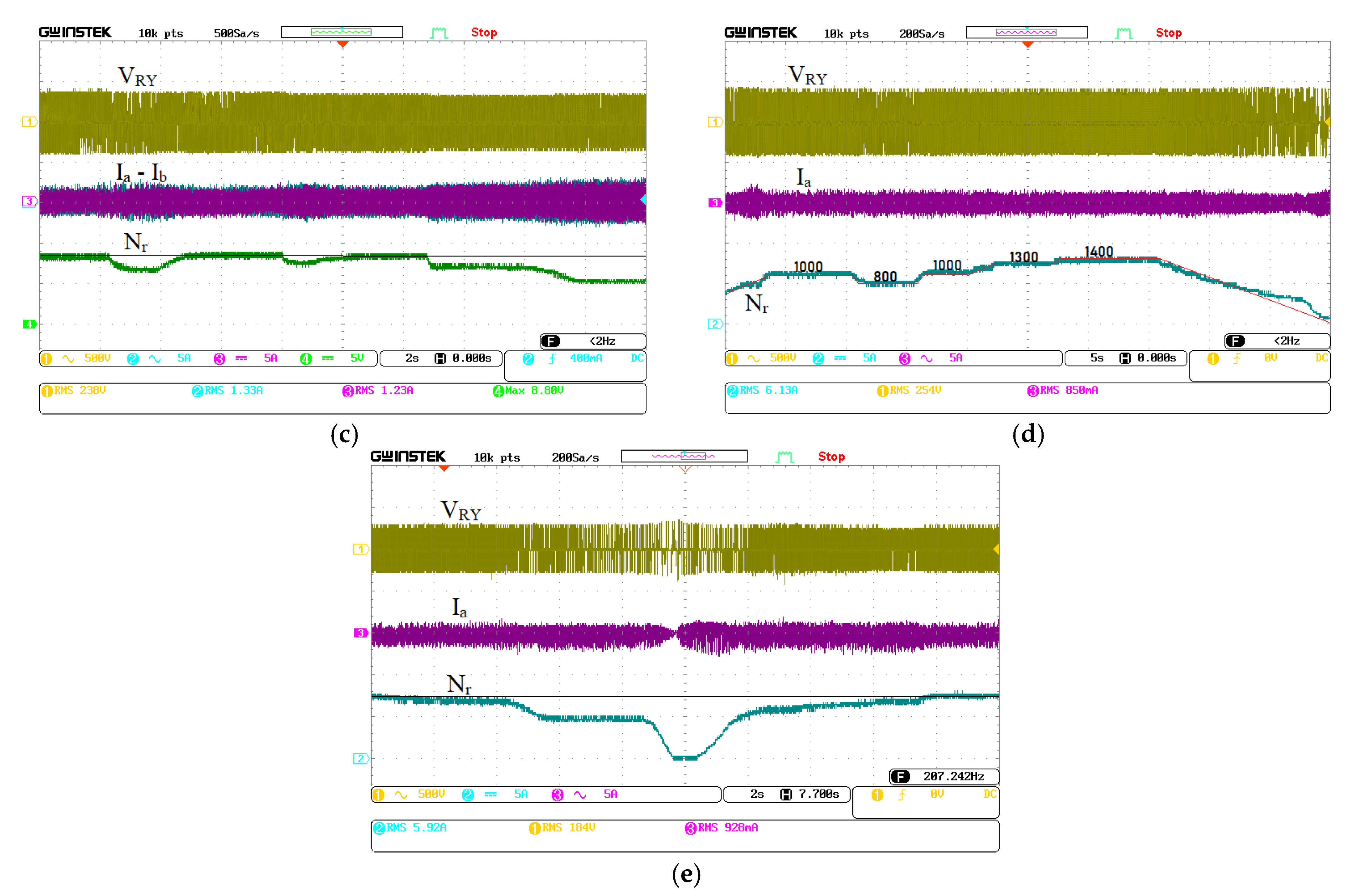

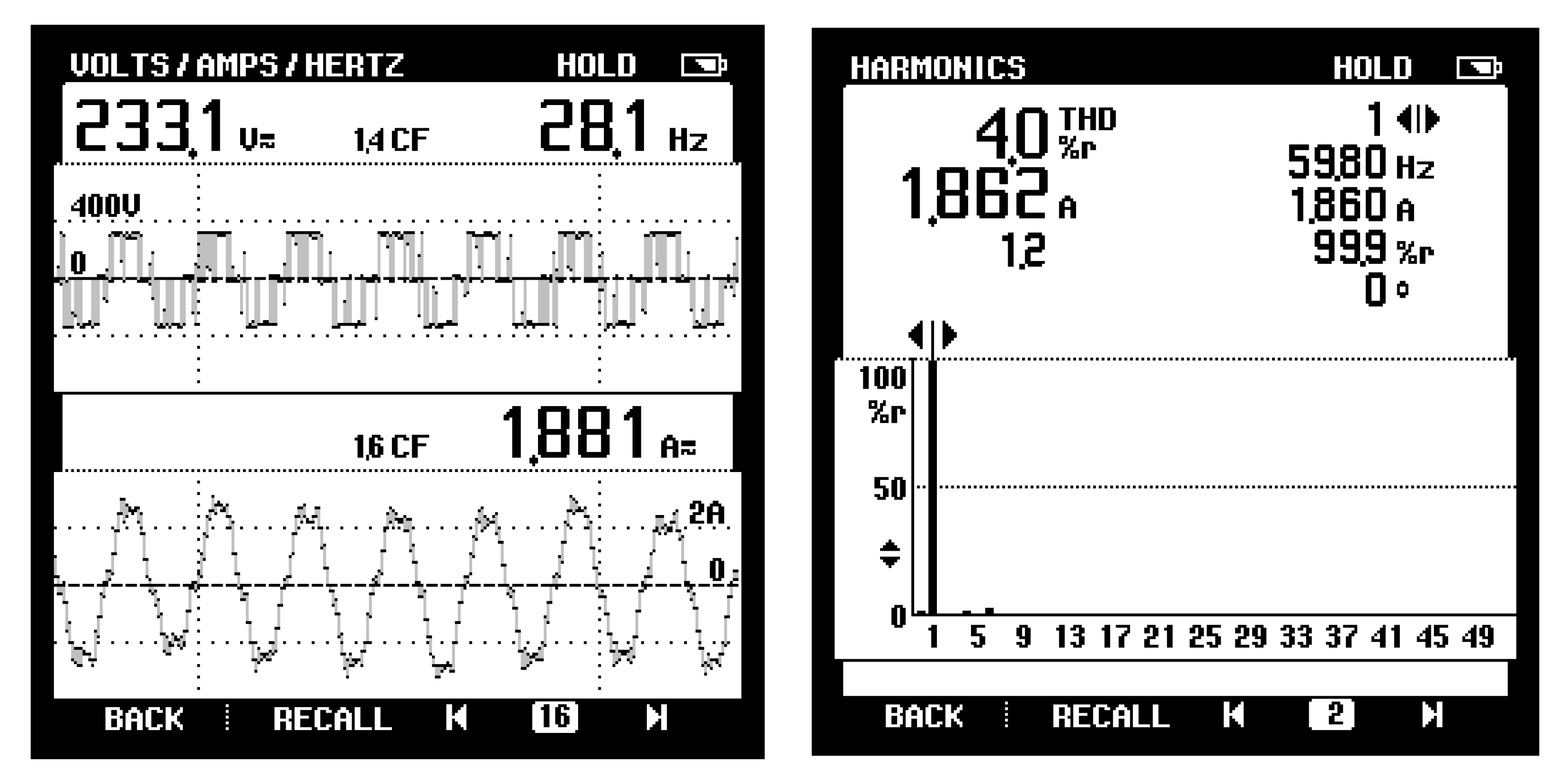



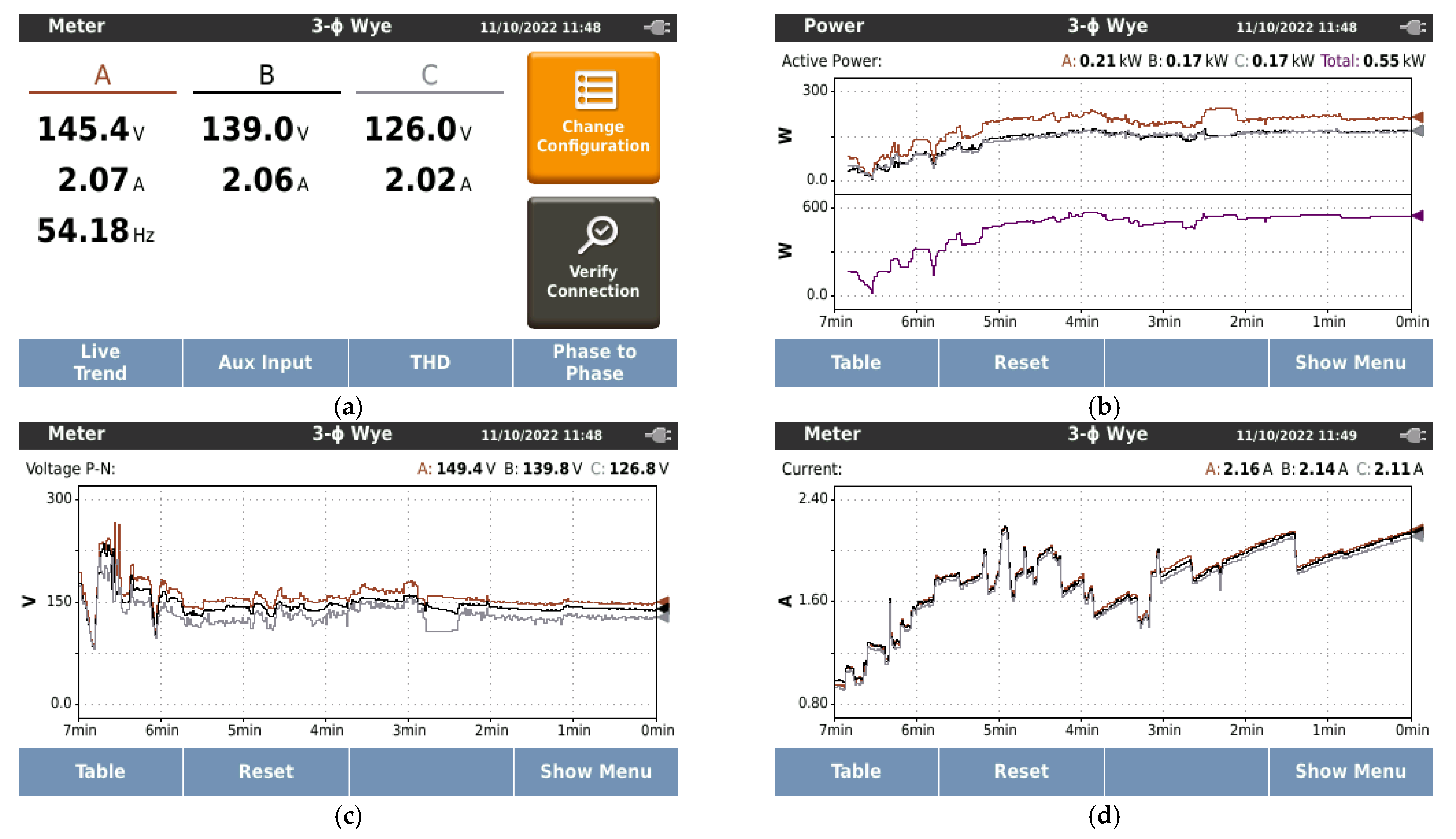

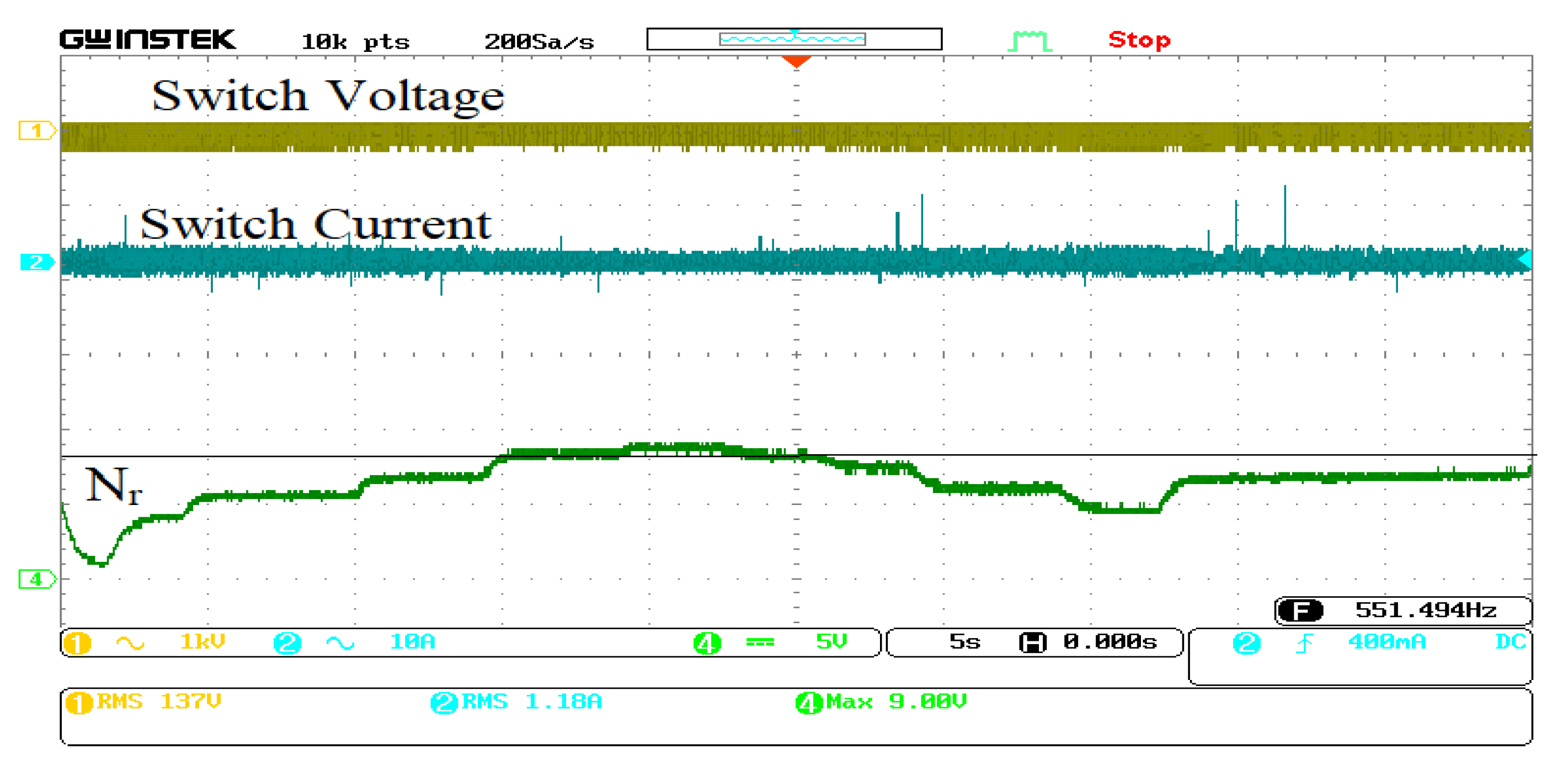
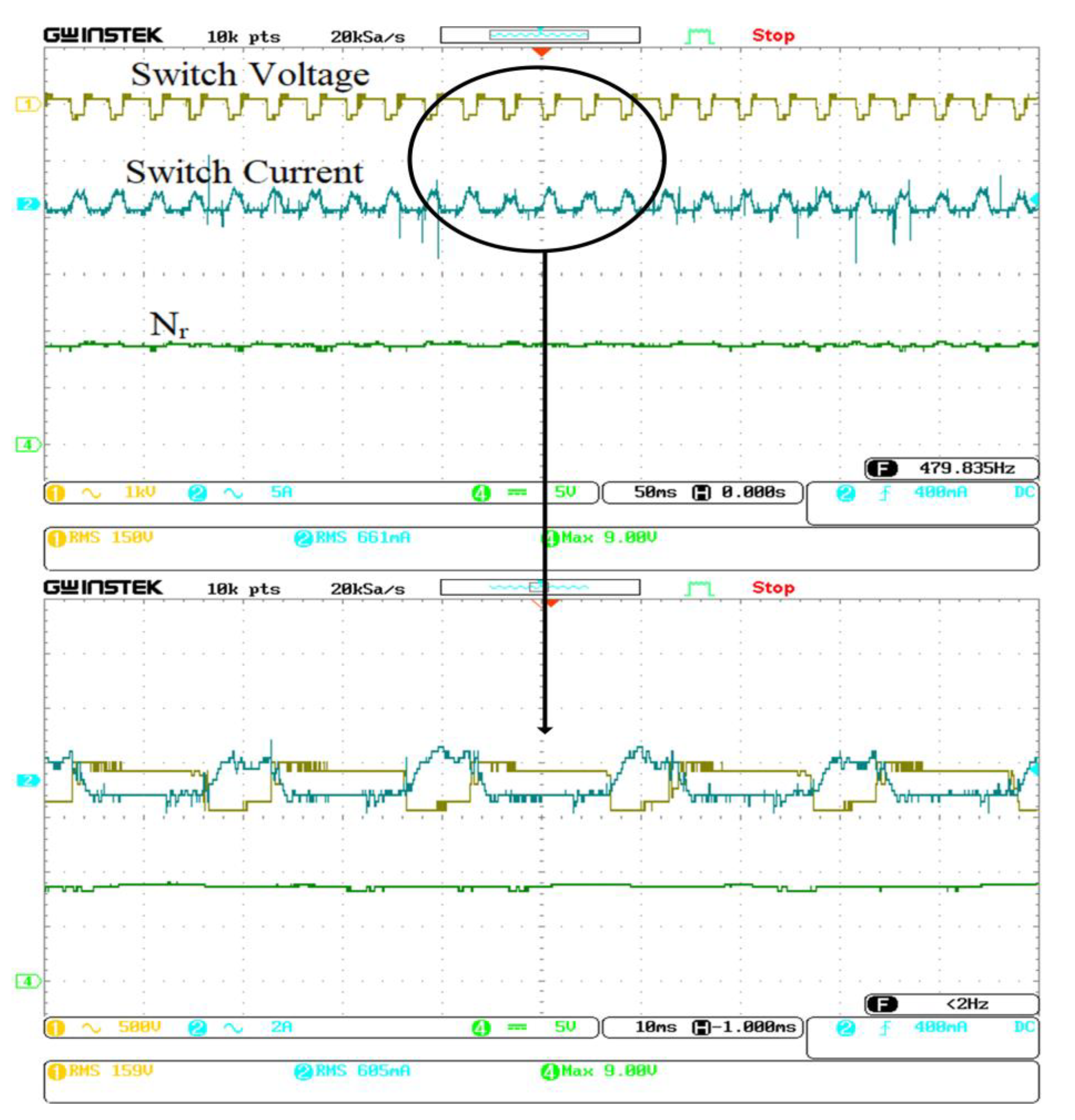
| Parameter | Value |
|---|---|
| Batt1 | 420 V Lithium Ion |
| Batt2 | 200 V Lead Acid |
| Power (IM.) | 33 HP |
| Voltage (IM.) | 400 V |
| Rs | 0.435 Ω |
| Ls | 4 mH |
| Rr | 0.816 Ω |
| Lr | 2 mH |
| Inertia | 0.09 kg·m2 |
| Rated Rotor Speed | 2000 rpm |
| Parameter | Value |
|---|---|
| Device for switching | 1200 V, 25 A, IGBT IRG4PH50KD |
| Main source | 450 V dc using a bridge rectifier |
| Supplementary source | 300 V dc using a bridge rectifier |
| controller | dSPACE1104 |
| Sampling time (Ts) | 150 μs |
| Switching frequency | 1 kHz |
| Operating frequency | 50 Hz |
| load | Induction Motor-dc Generator set |
| Induction motor specification | Vrms = 415 V, IL = 1.75 A, 1410 rpm, star-connected |
Disclaimer/Publisher’s Note: The statements, opinions and data contained in all publications are solely those of the individual author(s) and contributor(s) and not of MDPI and/or the editor(s). MDPI and/or the editor(s) disclaim responsibility for any injury to people or property resulting from any ideas, methods, instructions or products referred to in the content. |
© 2023 by the authors. Licensee MDPI, Basel, Switzerland. This article is an open access article distributed under the terms and conditions of the Creative Commons Attribution (CC BY) license (https://creativecommons.org/licenses/by/4.0/).
Share and Cite
Gudhe, S.; Singh, S.; Rezkallah, M.; Chandra, A. Dynamic Control of Traction Motor for EV Fed via Dual Source Inverter with a Two Battery System. Energies 2023, 16, 1754. https://doi.org/10.3390/en16041754
Gudhe S, Singh S, Rezkallah M, Chandra A. Dynamic Control of Traction Motor for EV Fed via Dual Source Inverter with a Two Battery System. Energies. 2023; 16(4):1754. https://doi.org/10.3390/en16041754
Chicago/Turabian StyleGudhe, Siddhant, Sanjeev Singh, Miloud Rezkallah, and Ambrish Chandra. 2023. "Dynamic Control of Traction Motor for EV Fed via Dual Source Inverter with a Two Battery System" Energies 16, no. 4: 1754. https://doi.org/10.3390/en16041754
APA StyleGudhe, S., Singh, S., Rezkallah, M., & Chandra, A. (2023). Dynamic Control of Traction Motor for EV Fed via Dual Source Inverter with a Two Battery System. Energies, 16(4), 1754. https://doi.org/10.3390/en16041754








